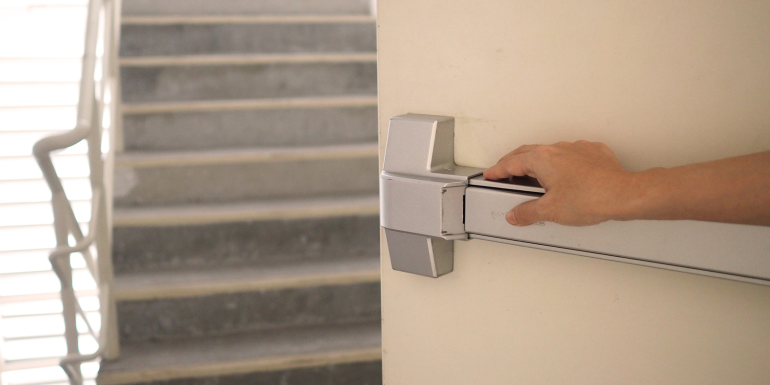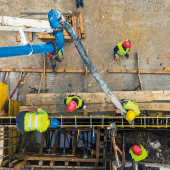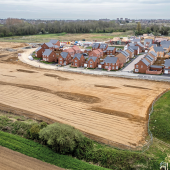Getting a handle on fire door ironmongery

We speak to recent CABE Webinar Wednesday expert Douglas Masterson about how the right architectural ironmongery on fire doors can be the difference between life and death.
When it comes to architectural ironmongery, CABE really couldn’t have found anybody better qualified to present its November Webinar Wednesday episode than Douglas Masterson. Douglas started in the business as a teenager, working weekends in his local hardware store in Belfast then staying on whilst also studying at Queen’s University.
After graduating, Douglas worked his way through the industry from trade counter right up to senior management, and now, he is the Guild of Architectural Ironmongers’ (GAI) Technical Manager. This role allows him to represent the architectural ironmongery industry in a number of ways, including assisting in the revision and creation of standards at British (BSI) , European (CEN) and International (ISO) level. It has truly become a way of life for Douglas. But get it wrong, he says, and it can also be a matter of life or death.
“If there’s one thing I would like to come from my CABE Wednesday Webinar it is awareness: awareness of how important ironmongery is as a component of a fire door and an escape door,” Douglas says.
“The one thing about ironmongery is you tend to find people take it for granted. You go into a building and put your hand on a pull handle or a lever handle, or an escape device. You don’t even think about who specified it, who thought about it or how it complies with building regulations.
“The reality of ironmongery or architectural hardware is that very often you will only notice it when it’s wrong. If you have the wrong door closer on the door and your fire door doesn’t shut properly in to its frame, or the wrong hinge supplied and the door drops and binds on the floor, then your fire door will no longer work as a fire door. Another example is if someone supplies the wrong type of hardware on an escape door and there is a fire, people can be injured or potentially killed. So these are literally life safety products that we teach people about at the GAI.”
Specs appeal
Specifying the right hardware for the right application is fundamental, and it’s something that the GAI runs specific courses to help people get it right. GAI provide diploma courses on specifying ironmongery, door systems, access control, and standards and regulations, each one of which can take up to three years to complete. In addition to this GAI also have a CPD programme entitled RegAI which allow its members to demonstrate their ongoing competence by achieving 20 CPD points in a calendar year.
“I’ve been involved in many major projects, massive hospitals and even the Aviva Stadium in Dublin where we had more than 100 types of different hardware sets,” Douglas says.
“You have to consider so much: the different types of door closing devices, the different types of lock – is it latched, is it an escape lock, does it require panic hardware or emergency escape? Particularly for fire doors, it’s about ensuring the fire doors have the correct specification of hardware, the correct intumescent seals and that it all fits together and has the correct fire test evidence. As architectural ironmongery specialists we work very, very closely with architects, specifiers and project managers to get it right.
“Then, at the end of the project, architectural ironmongers will work with end users and contract managers to supply the master keyed cylinders, therefore ensuring the client has the right keys to open the correct doors; and equally, to make sure nobody can get in to places they’re not supposed to. There is a huge amount of detail regarding architectural ironmongery that is very often lost. That’s what we teach our members and students on our courses – what the products are, how to specify a project, how to master key a project, and how to ensure you use the right product for the right job.”
Doors done badly
Douglas’s webinar is fascinating to watch, not least the selection of photos of ‘fire doors done badly’, the most notable of which features one fire door with a large rectangular section cut away to accommodate the rails of a stairlift.
Even to the layman, it’s a ridiculous error, but Douglas also highlights less obvious but equally important factors, such as ironmongery maintenance and fire door inspections. Fines in the UK for faulty fire doors reached almost £1 million in 2015, according to research by the Fire Door Inspection Scheme (FDIS), and in addition to the large number of fines given, many defendants were also handed suspended prison sentences.
“Inspections are massively important. People often think of a door almost as a piece of furniture – just put it in the building and forget about it. But there is ongoing wear and tear of key products such as door hinges and door closers and locks,” Douglas says.
“For example, think about a public building such as a hospital or a school, the doors will get a huge amount of use and abuse. Keeping an eye on maintaining them and inspecting them is hugely important to ensure that the ironmongery stays in good condition. If it doesn’t, the ironmongery will not work as designed and therefore your fire door will not work as designed.
“So what I would say to CABE members is, if you want to know more about life safety, then this webinar is a good place to start – you’ll find out about the correct components to specify for fire doors and escape doors, and realise that these are all safety and life critical products.”
Ironmongery maintenance tips – hinges
- Tighten and replace any missing fixings.
- Check for wear at knuckles.
- Check for rising pins.
- If door has dropped, replace all 3 hinges with better quality.
- Consider self-lubricating, long-life bearings.
- Hinges on fire and escape doors must be UKCA/CE marked to BS EN 1935.
Ironmongery maintenance tips – closers
- Closers on fire and escape doors must be CE/UKCA marked to BS EN 1154.
- The door must fully close from any angle.
- No mechanical hold-open devices.
- Controls concealed or tool-operable only.
- Delayed action not to exceed 25 seconds.
- Are there any leaks?
Watch Douglas’s Webinar Wednesday presentation below.
To see all CABE’s webinars, visit: https://cbuilde.com/general/custom.asp?page=webinar_page









